I think there was a distinct period in my childhood when I believed that the Phantom and Mandrake the Magician were Indian comic book characters. Indrajal Comics had been publishing these (and other King Features characters) in India since the 1960s and on visits to the country I’d occasionally read old issues. But these visits were few and far apart, and by the time I moved to India in the 1990s Indrajal had folded. So I’d never read the Timpa stories that Indrajal serialised as backup features in the late 80s until recently, when Pop Culture Publishing brought out four full-length adventures.
It’s obvious from the style of the art (and from the fact that creator Jhangir Kerawala freely admits to it) that the Timpa stories are heavily inspired by Hergé’s Tintin comics. Timpa is a boy detective as well, though in somewhat more realistic circumstances; he’s an actual child for one thing, and is only taken seriously by anyone because his (alarmingly indulgent) father is a police inspector. Timpa’s Calcutta is one where market shopkeepers sleep half the afternoon, where policemen occasionally take bribes, and where middle-class Calcuttans will always argue with rickshaw or taxi drivers about fares—this is a world I recognise. Tintin flies all over the world (and occasionally into space); Timpa takes trains and buses and doesn’t get further than the Andaman islands. His dog, “Rexy”, is always portrayed as a dog. He may chase the occasional cat but we never know what’s going on inside his head, as we do with Snowy.
Like Tintin, Timpa himself is fundamentally dull. There’s not much to him, other than an earnest need to help, and he stumbles onto things through sheer coincidence more than by any exciting process of deduction. Like Tintin he has a cringingly grateful faithful companion—Kalia, who is of a distinctly lower class, is tellingly dark-skinned, and is apparently incapable of defending himself against children without Timpa’s help.
But the really important character here is the grandfather who joins Timpa on his adventures. Grandpa has Captain Haddock’s belligerence combined with some of Professor Calculus’ talent for misinterpreting a situation. He’s grumpy, convinced of his own misunderstood brilliance, and often imagines himself as a superhero, or at least super-muscled. He’s also convinced that he’s the brains of this operation, though in this he is sadly misguided.
Grandpa gets all the best lines because in addition to being the comic relief he’s also the background voice snarking at (and therefore somewhat deflating for the reader) Timpa’s heroic plans. At one point Timpa drags him into a grand attempt to break out of prison a friend who has been sentenced to death. Grandpa is seen muttering darkly in the background about the whole thing possibly inspiring real murderers like Charles Sobhraj.
As I write this I realise that in a sense Grandpa is this series’ Snowy as much as he is its Haddock. A wry commenter placed partly outside the text by a refusal to entirely play by its rules: Grandpa rarely accepts the obvious realities of the plot.
Pop Culture appear to have faithfully reproduced the original comics, flaws and all. Sarbajit Sen, the artist for the first two books (The Red-Hooded Gang and Operation Rescue) appears to me to be a far superior artist to Avijit Chatterjee who did Runners of The Golden Horn and Legacy of the Gods. We’re given no clues as to who was responsible for the mystifying decision to have all the text in Operation Rescue be in cursive. And Kerawala’s grasp of the English language isn’t always all it could be. (He has now written a Timpa novel, The Soothsayer of Sealdah. I do not recommend it.)
And yet. Kerawala’s Calcutta feels just right, Timpa’s father and Grandpa are fantastic (his mother, who is usually the sole female character, sort of hangs around in the background weeping about her son’s safety). I complain about the less than perfect use of English, but Kerawala clearly has enough command over the language to make wordplay something that his characters indulge in almost instinctively. Timpa may be a lukewarm Tintin ripoff, but his setting and the people around him feel a lot more real than the people in Tintin’s world. If not necessarily realistic.
Which brings me to the real reason to read these comics – the fourth one, Legacy of the Gods.
Rereading Hergé’s Flight 714 last year I realised that it had first been published in 1968, the same year as Erich Von Däniken’s Chariots of the Gods? Von Däniken’s theory in this book (popular with teenagers around the world, or at least it was in my day) is that in Earth’s far-distant past it was visited by various extra-terrestrials whose far superior technology made them appear as gods or angels to our primitive ancestors. Flight 714 has Tintin and his companions taken aboard a hijacked plane to an island that, the natives claim, was once visited by gods in “fire-lorries”. There are statues that look suspiciously astronaut-like, and a strange man who can communicate telepathically, but aliens wipe the characters’ memories of these events before anyone else can be told.
I’m not sure if it was coincidence or a deliberate continuation of the Tintin theme that prompted Kerawala to do a Chariots of the Gods?-themed Timpa story. Legacy of the Gods opens with a direct reference to the book when we see Timpa’s father reading Von Däniken.
Soon after, Timpa visits an uncle in Murshidabad, stumbles upon a secret underground chamber and finds ancient scrolls written in an unknown script.
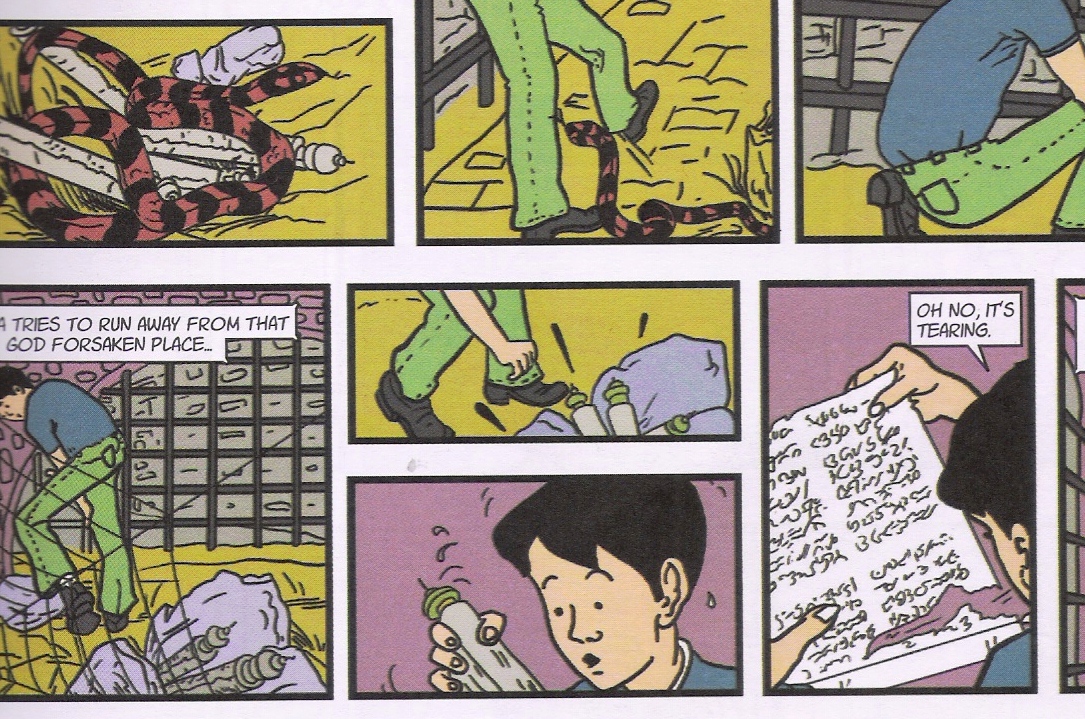
As Timpa suffers from a raging fever caused by snakebite he dreams of a strange man (we will learn that he is an alien) who warns him that the knowledge in these 14,000 year old scrolls is dangerous to humans. The alien’s name is … Vladimir. I cannot explain this. I also cannot explain why Vladimir has sparser chest hair and better skin on the cover of the book.
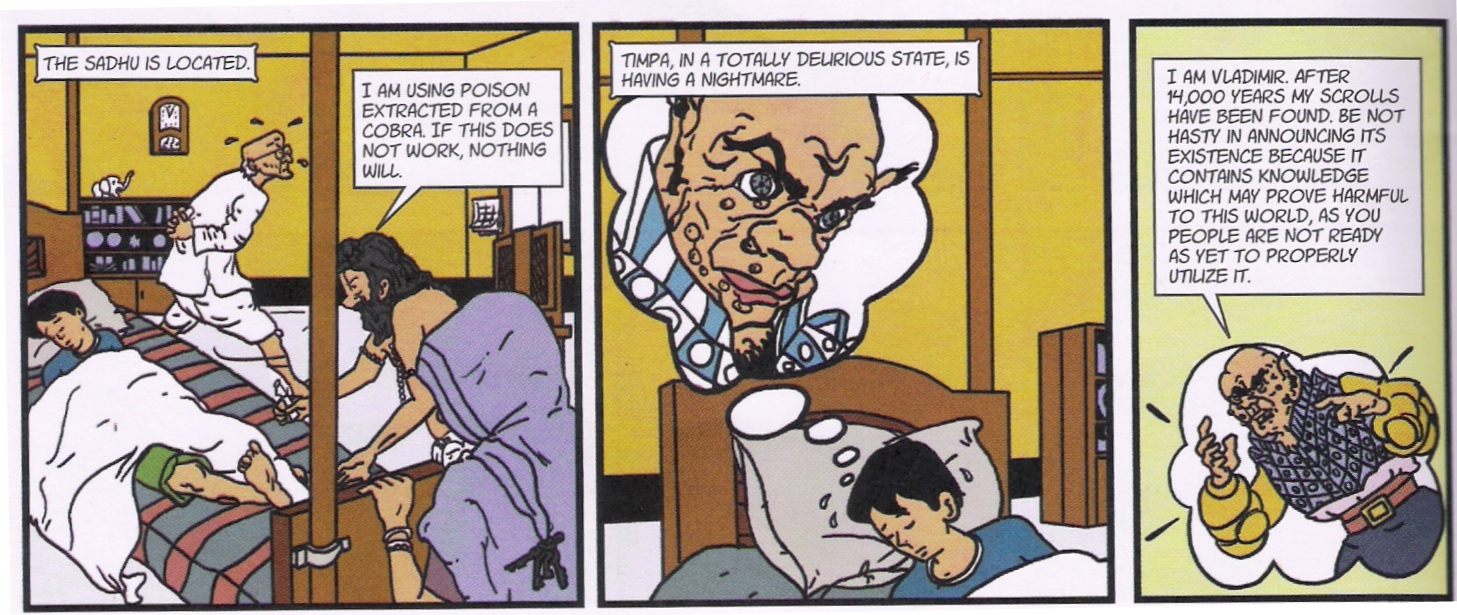
The scrolls, it turns out, are in an old form of Pali. Naturally the Indian government fails to listen to young Timpa’s insistence on the importance of these scrolls. Naturally the Americans and the Russians (this is set in the 1980s) are interested. A series of kidnappings and interchangeable villains follow.
Naturally the Americans almost get away with it. Until the Russians blow up their helicopter.
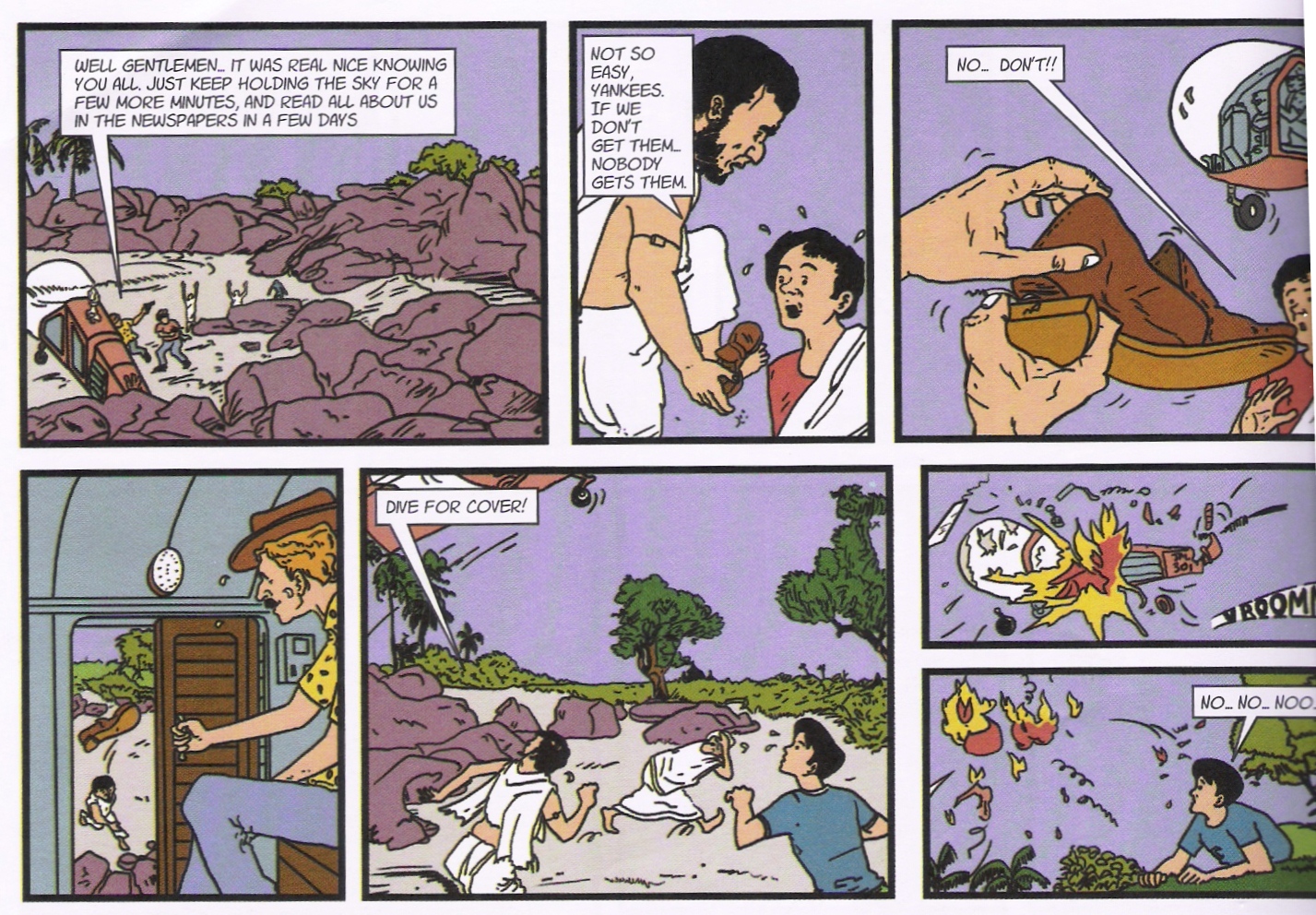
And so once more, great (or terrible?) knowledge is lost to the world.


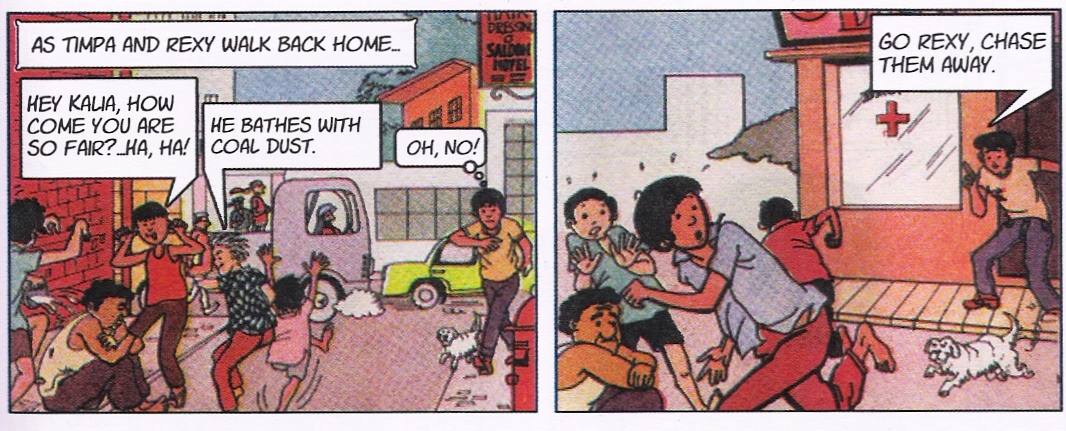
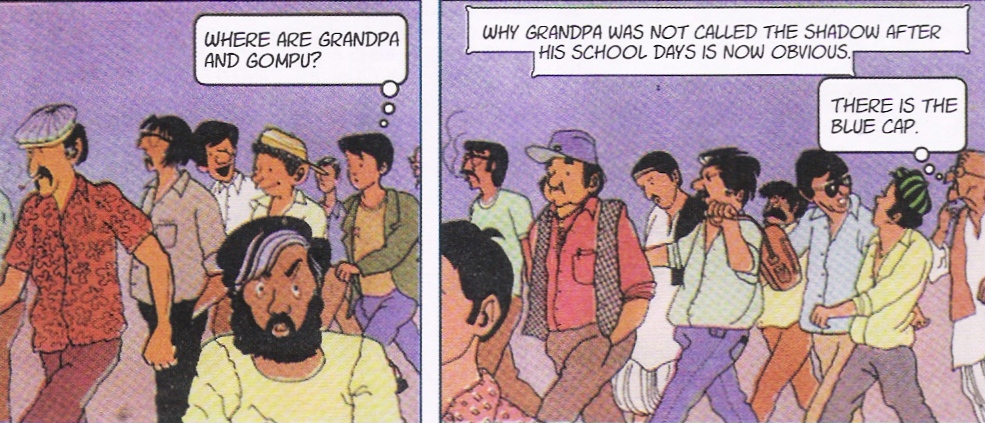
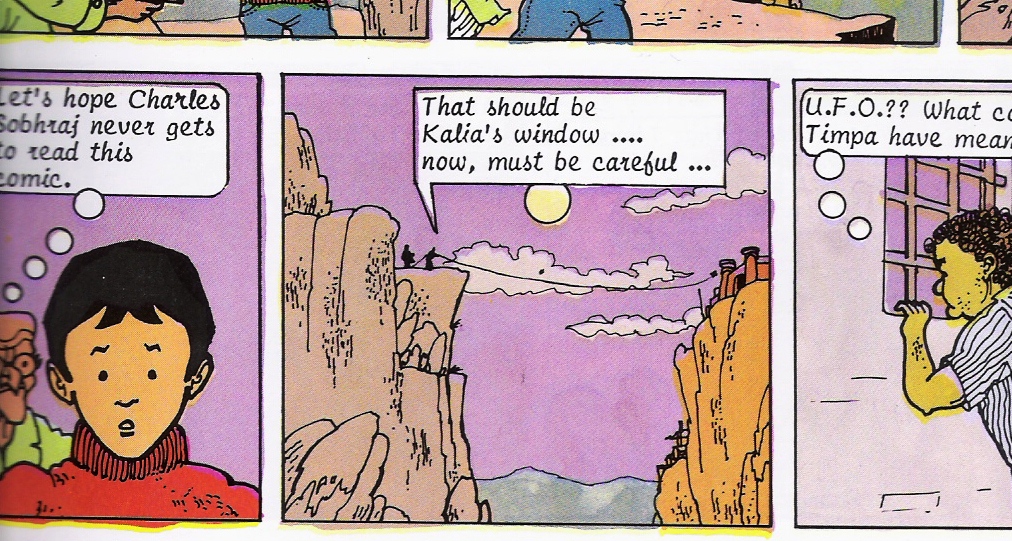

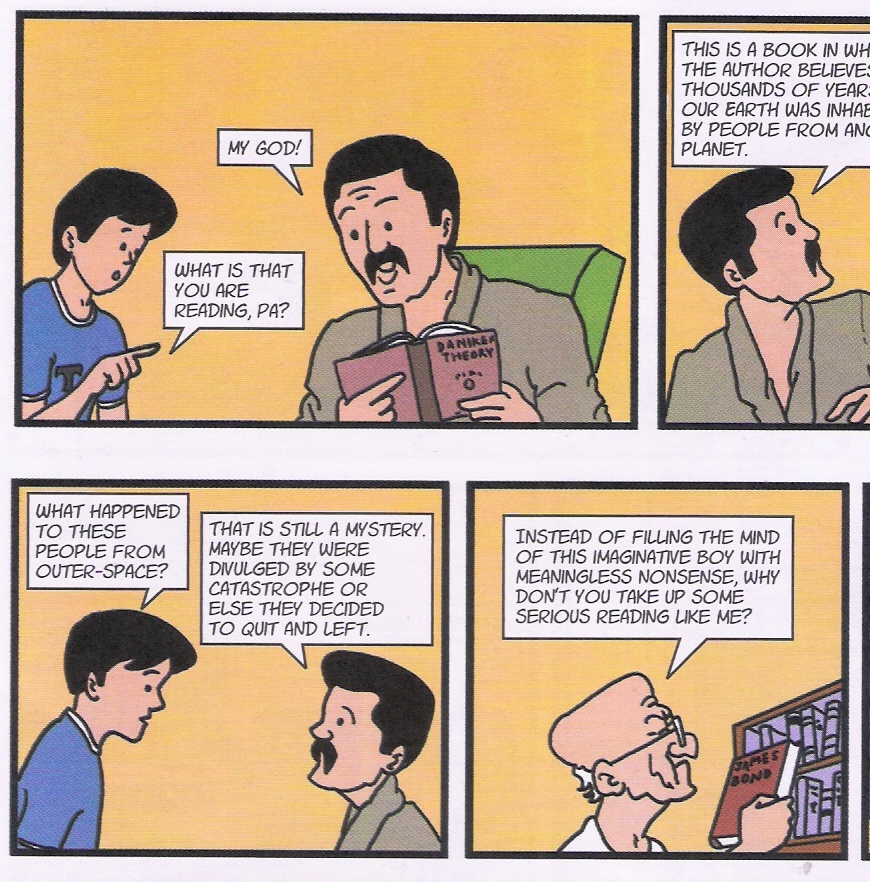
This sounds really intriguing!
Pingback: Comics A.M. | This weekend, WonderCon returns to Anaheim | Robot 6 @ Comic Book Resources – Covering Comic Book News and Entertainment
Great article. I think that in most respects, Tintin is the perfect archetype of an Indian child’s hero.
Could you expand on what you mean Mahendra? I’m intrigued.
Tintin respects his elders, seems well-educated, has superb manners and most importantly, he is incorruptible and brave.
No matter how bizarre and dangerous his adventures, Tintin always seems to be at home. He is self-contained, thanks to his complete identification with his own society and culture. He never doubts his origins. And he never doubts his superiority, or at least, competence.
He always protects his culture, both physically and morally. He never lets the side down. The latter is very important to all Indians, regardless of class/religion. Letting down your side is letting down the family, in essence, and the family is everything to you.
The family is the building block of culture, and furthermore, the traditional aesthetic aspects of this culture are still a living thing. I think the visual neatness of Hergé’s clair-ligne style appeals to this orderliness in the Indian cultural make-up. Indians do not practice much order in other matters, but their artistic/educational culture is very structured and nuanced.
Perhaps most North Americans regard all this as a boy-scout sort of character, a bit boring, perhaps? … and I suspect that some modern Indian children may now find Tintin boring also.
The conservative ethos of the now mostly-vanished, middle-class, Catholic European culture that Hergé imbued his BDs with is still the dominant ethos of the Indian family circle.
I have always adored Tintin. But it is not a great comix, really. It is superb commercial work for children exclusively.
Well put.
The only problem that I see is that Tintin doesn’t really have a family. His mother would have been worried sick every time that he travelled to some far away land. I can also imagine his mother and father trying to find him a suitable bride. They would try to bring him to his senses and settle down.
Well put!
In fact Hergé, Tintin’s creator, was requested by one of his Catholic mags, to create an adventure series whose heroes would have a “normal” nuclear family behind them.
The result was “Jo, Zette, et Jocko”, which Hergé quickly gave up: the constraints were too much for him.
For me, anyway, Tintin is a sort of blob, an empty space for me to project my fantasies of identifications into.
Any hint of parents would kill that stone dead — and Hergé knew it.
Yes, you’re right. Maybe Tintin has adventures because he is saerching for his family?
He was stolen from the hospital at birth and raised by a pack of wild journalists but one day he will discover that Inspector-sahibs Dupont and Dumont are his long-lost brothers. Also Rastapopoulis. They will also discover that Castafiore is their real mother but she will die in a lengthy, noisy hospital scene. Afterwards, another song, another dance, a water-sprinklered girl in a chiffon sari will break his heart and marry Capt Haddock instead and Tintin flees online, searching the Hooded Utilitarian matrimonial ads for a nice girl who can cook just like Professor Tournesol/Calculus.
The Hooded Utilitarian only allows weddings in panopticons. All others are inefficient.
All Indian weddings are panopticons, I can assure you.
I assume Tintin’s recognition of his family will come about via the revealing of a mysterious birthmark?
Yes, of course!
If only Steven Spielberg had listened to us, he would have had a smash hit with Masala Tintin. But I’m guessing that Bollywood already has something similar in the works.
Somewhere or other I came across the concept that Tintin is actually Rudyard Kipling’s Kim, though I can’t seem to find the original claim online now.
I’d like to know more about the Tintin/Kim connection …
But you’re right, Tintin was a direct descendent of Kipling and even more so, Verne, particularly in opposition to the other 19th-century Francophone pulp tendency, such as Arsene Lupin, Rosny ainé, Jean Ray etc etc.
Indians still enjoy the classic Victorian Ripping Yarn.
Oh!… The joys of post-colonialism!…
There must be a birth mark. Most definitely!…
I seem to remember reading in Peeters’ biography of Hergé that his father was born from an illegitimate liaison between Hergé’s grandmother and an aristocrat. Talk about romanesque stories! Tintin’s birth mark will show that he was the illegitimate child of some baron. Maybe that’s why Hergé gave a fortune to Haddock and Tintin: his characters inherited what he could never claim.
Here’s Hergé’s putative half-niece writing about her family.
Ooops! It’s cousin, not niece.
A very well write-up! I was introduced with Timpa & Tintin almost at the same time…on 1989….and I loved both!Loved Tintin stories for obvious reasons and Timpa for a similar-series-with-Indian backdrop and of course,the local flavor(been from Kolkata). Like Haddock and Calculus from TINTIN series,grandpa(aka dadu) was my most favorite from TIMPA series!Infact I read these series for these side-characters mostly..
By the way,some info regarding TIMPA : this series was introduced by ‘Paras publication’ on 1986 and 3 titles were released on the same year([1]Legacy of the gods,[2]The red-hooded gang
& [3]Operation rescue).After seeing the series success,’Times of India’ bought the right of TIMPA on 1987 and since Feb’88 Timpa was a regular back-up character in the Indrajal pages till Aug’89..There were 36 new stories published in that period..
So before POP brought-back Timpa there were already 39 stories…now they have added 2 new but somehow I don’t find that charm in the 40th adventure…and yet to buy the 41st…
PS – You can click the label “Timpa” in my blog(The Lost World) and wiill find 3 posts from 2007-13…
Hello Aishwarya
This comment – after almost 3 long years – must take you by big surprise I’m sure. It so happened that I came across this blog a few days back while searching for some visual references of The Red-Hooded Gang.
Thank you so very much for your superb article and also for some fantastic comments that came from AB, Mahendra, Domingos and Sagnik.
I was instantly transported to those colourful days. I fondly remember each and every moment of the making of the books. There are so many interesting anecdotes and backstories that take me back to splendid moments spent with Ganesh Pyne who admired the job and also Mario Miranda who took the initiative to send it to BD’87, Switzerland.
I went through all those comments (both thoughtful and thought provoking) of Mahendra and Domingos and all the while I remembered how many debates and how many games of chess and bottles of beer it took us (me & Jehangir) to come to a point of understanding about the credibility of the characters. I did not necessarily want to blindly go the Tintin way. I decided to grasp the spirit of the Herge characters – in good humour. But I very much wanted to keep the Calcutta flavour alive. And in this Cal society a teenage boy as a lone crusader solving all the crimes would never be accepted – despite our awareness of those much used words: ‘willing suspension of disbelief’ – by the young middle class (mostly) readers who were our prime target readership. And again I knew about the pitfalls of keeping the comic book characters – at least in such stories -in a family. We have been through Jo, Zette and Jocko after all!
Timpa’s resurfacing at Comicon (Pop Culture) event was absolutely unknown to me till the 11th hour. I came to know about it from some sudden surprise calls at night from my young cartoonist/animator friends from Delhi and Mumbai. I was absolutely in the dark. Later Comicon sent me a complimentary copy.
Big thanks again for taking me back to those days in your colorful time machine!
Cheerio!
Hello Mr.Sen,it’s great pleasure to have your comment on Timpa.I was introduced with Timpa through Indrajal and was fond of his adventures with dadu.Much later got three books from 80s.My only quries regarding Timpa is,whether the length of stories were edited in Indrajal or you guys created that way to fit in there? Because stories usually were ave. 8 pagers while at books we got much longer.Thanks.